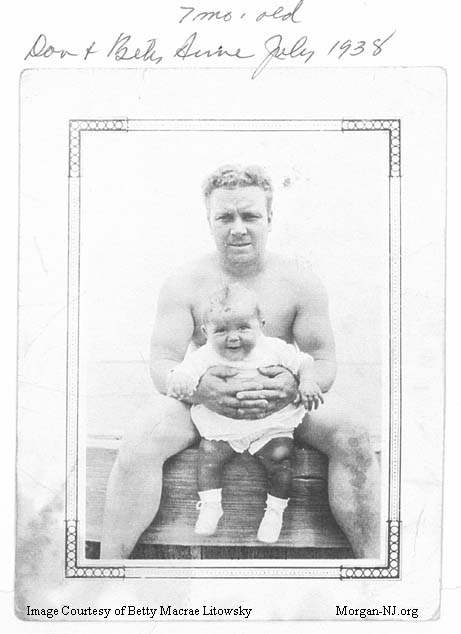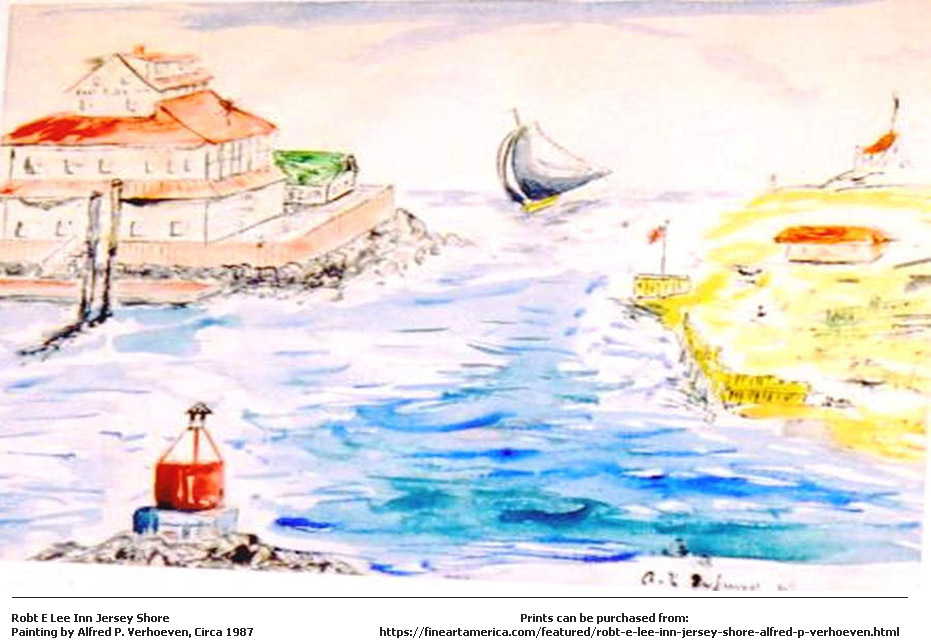
“Robt E Lee Inn Jersey Shore” Water Color Wet on Wet Painting by Alfred P. Verhoeven (1929 – 2013).
Prints are available in different sizes and prices from: https://fineartamerica.com/featured/robt-e-lee-inn-jersey-shore-alfred-p-verhoeven.html
Morgan Memories – Betty Macrae Litowsky’s Reflections of the Robert E. Lee Inn
Betty Litowsky shared photos and stories with us from her collection of fond memories growing up in the Robert E. Lee Inn across the channel from Morgan Beach. Betty is the child of Donald and Ruth Macrae who owned the Robert E. Lee Inn from the spring of 1940 through all of World War II until sometime in the 1940’s/1950’s. In the late 1930s, prior to acquiring the Robert E. Lee Inn from founder James Cady, her father Donald, Jr. owned a hot dog “shanty” on the Morgan Beach side of Cheesequake Creek on the north side of old Route 35.
Another page contains her Morgan Beach stories which can be read by clicking on this link.
This page has the most information regarding Morgan Beach as is currently known.
This is an introduction to Betty’s “Tales of Morgan.” Thank you to Betty for your memories!
Donald MacRae, Jr., (my father) was born in Newark, NJ on April 28, 1910, at home to a 17-year-old bride. His father, Donald MacRae, Sr. was also born in Newark as was his mother, Elizabeth (Geldhauser, aka, “Nanna”). Both parents came from large families, but “Donnie” would be their only child. These were very hard times, but both Elizabeth and Donald, Sr. were very enterprising. She took in hand work such as sewing and creating clothes for people who came to her with pictures or patterns. She also “caned” chairs, i.e., weaving cane across the seat or back of wooden chairs. They were both the eldest in their families, and had to grow up fast; Elizabeth, by working in a glass factory where many other young girls toiled from before dawn until after sunset. It was especially bad during the winter when days were shorter. She once told me after finishing fourth grade, she went to work in the dark and came home in the dark.
Don, Sr. had a little more schooling since he went to high school but since he was married, and with a child at age 19, he also grew up fast. Their pride and joy, young Donnie, was a beautiful little boy with a head of blond curls.
He grew up to be my father and could easily be described as my most unforgettable character.
My mother’s family was much more educated but they were more introspective and had a quiet humor. They were Floyd and Isabelle Keeler. He was an Episcopal deacon and teacher; she was a beautiful young writer. The story of their lives is an interesting one that I will tell sometime in the future but, until then, I will tell you about their daughter, Ruth (my mother.)
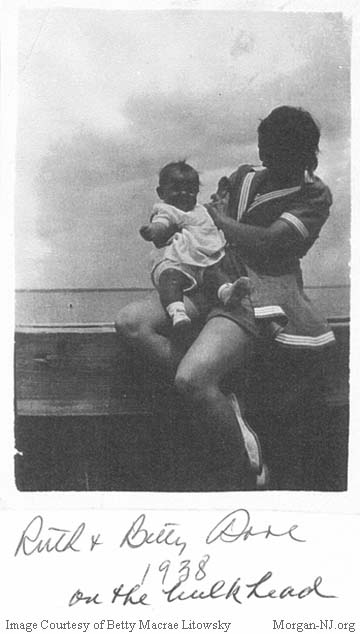
Ruth Macrae with her baby Betty Anne in 1938 at the Bulk Head of Morgan Beach in Morgan, NJ. Image Courtesy of Betty Macrae Litowsky.
When they met, my father was a 24-year-old “businessman”. He owned a little candy store in Newark along with a partner, Leo Ring, a Jewish boy that had been his best friend since kindergarten. They were both living the single life and loving it! In those days, many people had no phones in their apartments, and if they ever got a call, had to be summoned to the nearest public phone (as odd as this seems today, it was the way most people got their calls in the 1930’s).
Mr. and Mrs. Keeler and their children lived right above the candy store when a call came in from her editor. An errand boy ran up and knocked on their door. Ruth, their daughter, was given the task of bringing the editor’s message back to her mother, who was “indisposed.” “Boofie,” as her friends and family called her, hurried down to take the message for her mother. After exiting the phone booth, young Don saw her for the first time. He immediately approached her, but when he found out she was just ready to turn 17, he hesitated. Boofie began buying a lot of candy in the next few weeks, and, as Don put it in later years, “the rest is history.”
After a few months, they became engaged and were married almost exactly one year later (January 1935). They honeymooned in Washington, D.C. (there are many stories to tell at a later date about the blizzard that plagued their honeymoon). When they got back, Don decided to sell his interest in the store, to his partner, Leo (who was later to become the editor of the Newark Star-Ledger). It was time for him to set out on his own, and it was that summer that he bought “The Stand” on highway 35 which he called “The Hot Dog Shanty.”
When the summer was over, he went to work in Newark, where his father was the business agent for the Glazier’s Local 1095 (Editor’s note, a “glazier” is a person whose profession is fitting glass into windows and doors.) His parents convinced him that he could do both own a business and work as a glazier. He did just that his whole life.
I hope this brief history is enough to bring you up to the beginning of my Morgan stories. One thing I forgot to tell you is that sometime between my kindergarten and my third grade, we began spelling our last name with only one capital. I never knew the real reason (if there was one) but the spelling became “Macrae” instead of “MacRae.” I guess now we will never know why.
Here are my Morgan stories.

Don Macrae’s Hot Dog Shanty on Morgan Beach circa 1937. Don Macrae, Sr. on the left and Don Macrae, Jr. on the right. Image courtesy of Betty Macrae Litowsky.
I was born in St. Michael’s Hospital in Newark, N.J., on December 5, 1937. We moved to Morgan Beach in the summer of 1938. The young Don Macrae, who was a member in good standing with the Glaziers Union in Newark, was also an entrepreneur. He bought a small “Hot Dog Shanty” on the north side of the old highway 35 (which in 1938 was just about the only to get to the Jersey shore from any of the cities in the north). After running that small seasonal business, he had enough for a down payment on a house on Morgan Avenue overlooking the Raritan Bay.
With another baby coming in the summer of 1939, he began looking for another investment to augment his salary with the Glaziers Union. It was at this time he learned that the Cady’s Restaurant, right on the channel to the bay was for sale (the country was still in the throes of the depression). Many business people had invested everything into ventures that just could not hang on. The Robert E. Lee was one of those that failed. With some help from family, he was able to negotiate a deal with the floundering owner, and in the autumn of 1939, they sealed the deal.
Bringing two little children and his young wife to that big old Victorian building, with its failing heating system, high ceilings, and plumbing problems, they really had their work cut out for them! By the spring of 1940, they opened for business. It was a hit from the get-go! Since there was nothing like it anywhere in the vicinity, and the young owner was popular as a proprietor and master of ceremonies. It very quickly became the place most of the locals made as their second home.
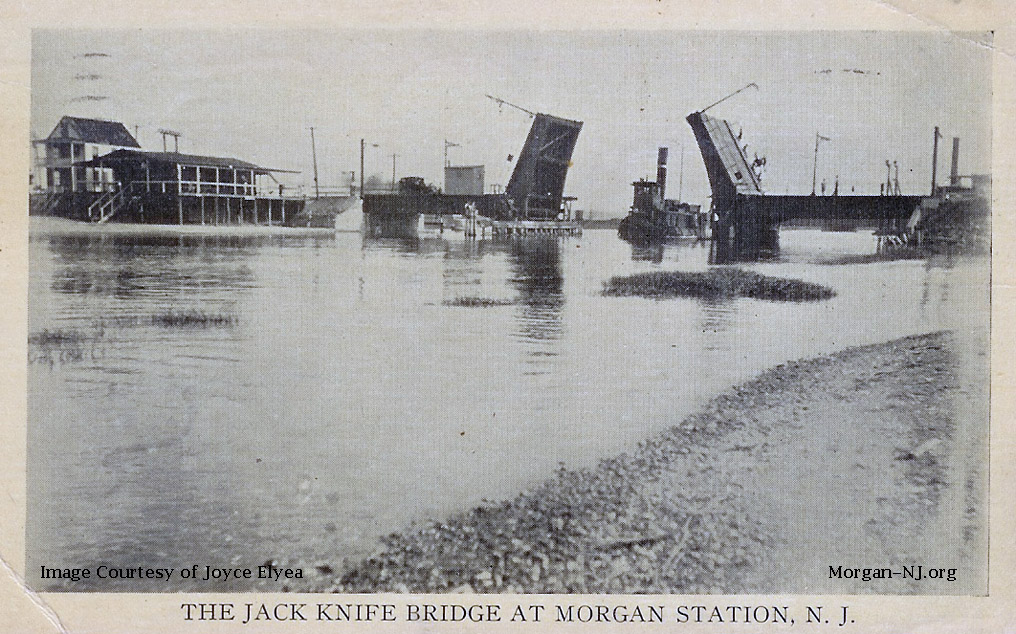
Historic Picture Post Card of the Third Road Bridge Built Over Cheesequake Creek. Image Courtesy of Joyce Elyea.
The Morgan Bridge [located right next door to the Robert E. Lee Inn] was an extremely important structure for anyone who lived within 20 miles north or south of it. That bridge connected the big cities to all the Jersey Shore destinations. Without it, people would have to find the back roads to get them onto the old Route 9 all the way inland. So that little wooden drawbridge held the key to a ride along the coast, passing each small bay front town until they got to one they liked. We, at the Robert E Lee, were the very first glimpse at any kind of waterfront views. I am sure we were not the original choice of many of our customers, but we became their chosen destination on many return trips. People always said that our motto, “The place where customers become friends,” was very appropriate, because even if it was your first visit, you left feeling as if you had found new friends. Having people come back after their first visit, was one of the things that Don reveled in! That was something he found very satisfying and, I think, gave him a distinct feeling of accomplishment!
The Robert E. Lee had water surrounding it. To the east, the Raritan Bay, and on the south was the channel. The channel was a narrow body of water that connected the bay to the shallows in the western marshes that meandered through miles of wetlands. There were boatyards that stretched all along the old wooden docks that had been built for the “rum runners” during the days of Prohibition in the 1920’s. In the entrance lobby of the restaurant was a telephone booth (just like the one Superman always used to change in). It was made mostly of oak with a folding door, that when closed, kept out much of the surrounding noise. That booth was our playhouse, “elevator”, railroad car and just about anything that two little kids could imagine it to be. I can still see my little sister opening that folding door just enough to put her head out and say “going up!” That entrance lobby had another play area that we made good use of; it was the hat check room. This was a long narrow room with a half door that had a kind of shelf that was waist high (for an adult) where on weekends my cousin Honey would earn tips as the “hat check girl.” There was a long dowel running back to front upon which the hangers hung the coats and jackets. With a large shell on top for the hats (both men and women wore hats in those days) it was 10 cents to check things for the night. A tearaway ticket with code numbers on it assured everyone got his own hat back at the end of the night.
Later, during the blackouts of World War II when there were air raids, that long narrow room was our bomb shelter. The air raid wardens would blow their whistles while the fire sirens screamed. Every blackout curtain was pulled, every light turned off – even the light in the small lighthouse at the head of the channel was doused. Everything was black except inside the check room where my sister and I sat at the far end with a flashlight, coloring or reading our books.
The third floor consisted of one “Suite” (a bedroom with a bathroom) and the rest consisted of five small bedrooms. There was a massive general bathroom at the north end of the hall. There was a wall of three or four sinks, two stalls with toilets and a huge claw foot tub that was long and deep. Over the years we had a dizzying array of traveling salesmen, servicemen (mostly Coast Guard) and any of a variety of “handymen” that did odd jobs for their keep. One man, a carpenter from Newark named Don Kramer, was one of my personal favorites. He could do anything. He built large toy boxes for Jeanne and me. They were shellacked wood, whose grain was very swirled. They were plenty big enough for us to lie down in and hide among the toys. They were set up on each side of the spare room on the second floor, which is where our family had its quarters. From the small entry just off the main lobby there was a staircase going up to a landing, and to the right was the hall connecting our rooms. There was a living room with hardwood floors and a large maroon print Persian type rug with fringe at each end. That room faced the front of the building and had two large windows with stripped awnings over them. There was also a window facing the south that looked out over the water. There were three bedrooms with really large closets that connected the rooms by crawling through the small passage ways around the outside perimeter of the building. Just off the landing at the top of the stairs, to the left, was the “liquor room,” which was always locked, and a large dining room with a big wooden table.
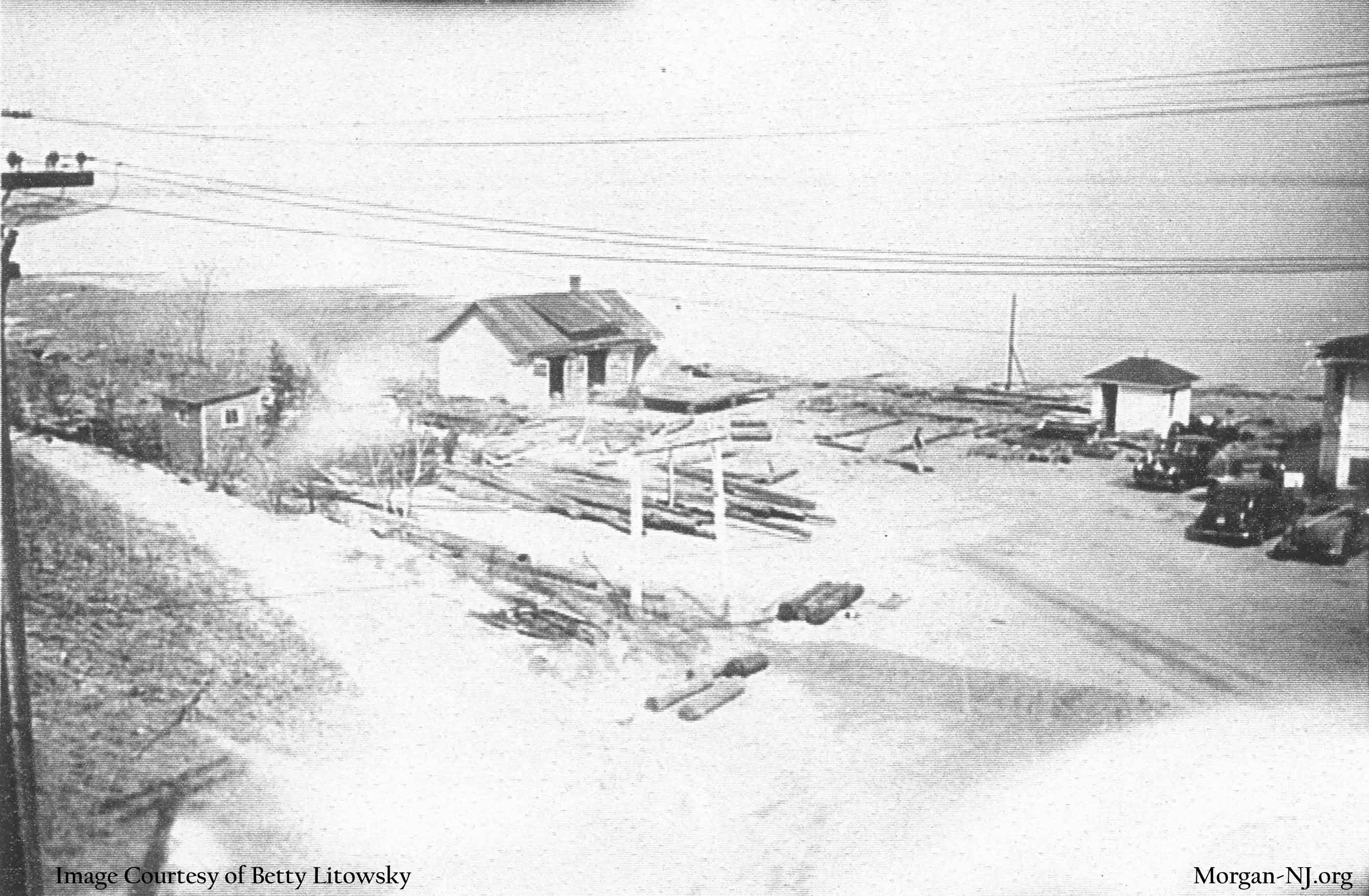
Looking north to the yard at the Robert E. Lee Inn in preparation for installation of the World War II Army surplus barracks as seen from Route 35, circa 1945. Image courtesy of Betty Macrae Litowsky.
Looking out over the yard to the north were the attached garages that we called the carriage house. At the end of that hall (which had a banister on the left and a wall on the right) was the “playroom. We were allowed to do almost anything in this room. For example, it had white plaster walls. We were allowed to draw and write on those walls and had every grownup that could be coerced into it, come upstairs and draw pictures (and everything had to be signed) so when the next person came, we could show all the others who had done the same!
The grounds had its dangers, too: deep water on two sides, a busy highway on another, and lastly (maybe most dangerous), the railroad tracks. I always wished I could ride on one of those track buggies that were operated by two people by pumping the see-saw contraption up and down. The faster they pumped, the faster they flew down the tracks. They were inspected for any flaws or loose pieces of debris that may have fallen, been blown onto, or put there purposely by vandals (laying a penny on a railroad track was said to cause a train wreck). I can’t believe that would be true, but that is what “the bad boys” at school told us.
On a beautiful clear Sunday in December a big family party was planned to celebrate the birthday of their curly-haired little girl, Betty Anne (my birthday was actually on the previous Friday, but they wanted everyone from the family to attend, so it was planned for the 7th instead of the 8th). As the tables were being set with decorations, the waitress came running out of the back kitchen screaming, “they are bombing us – it’s war!” I will never forget that day. Pearl Harbor was our entry into WWII. I was four years old. That day is clear in my mind. From that time on times were different. Anyone who lived during those years will agree – we were all in it together. Everybody and I mean everybody did their part. Old people, little children, literally everyone did their part. We grew our own vegetables in our victory gardens, saved string, rolled any silver foil we could find (usually from cigarette packs), and used our ration stamps. So much was rationed, meat, butter, sugar, gasoline, even shoes!
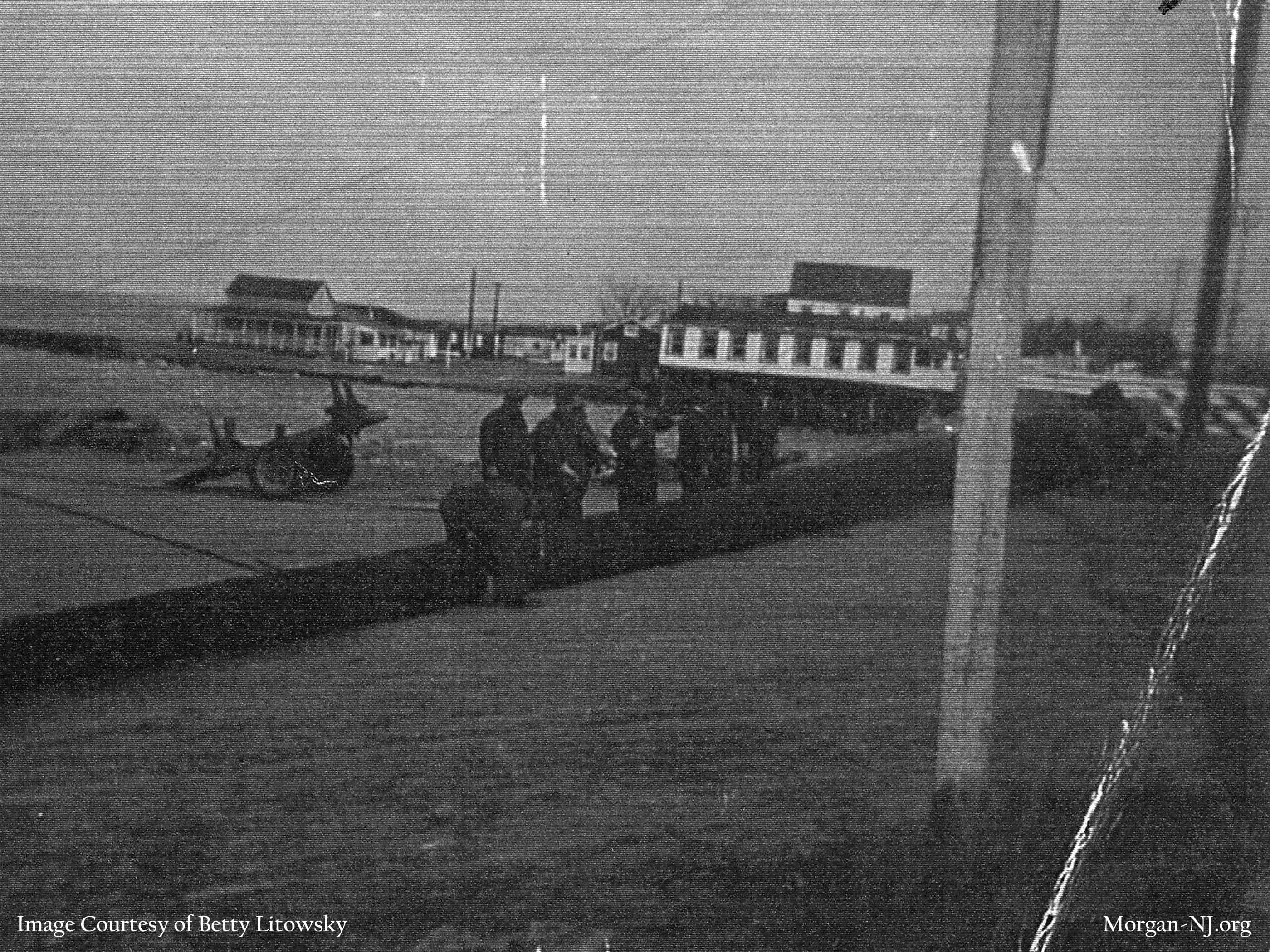
Looking across Cheesequake Creek Channel toward Morgan Beach from Robert E. Lee Inn in the 1940’s sometime after 1943 during a very high tide. “Hock’s Pavilion” / Blodgetts Rooming House on the left, Morgan Beach bungalows in the center, and Kaiser’s Tavern on the right. Image courtesy of Betty Macrae Litowsky.
When the state of New Jersey wanted to widen the highway, they also needed to dredge the creek so the Coast Guard cutters could navigate more easily. All of this was going to require a much bigger bridge than the little wooden drawbridge that was there. The bridge tender’s house sat right on the landing near the entrance to the Robert E. Lee and the bridge tender pretty much lived in that little square house. Sometimes he would have a friend visit and they would make twine fishing nets which they then sold to Millie (the woman who owned “Millie’s Bait and Tackle” on Old Spye Road). This road was built during the Revolutionary War and, yes, George Washington was purported to have stayed at the Ye Old Spye Inn. This historic Inn was built right beyond the creek to the west where the marshlands begin, probably because it would have been hidden from any of the English ships that may have come into the bay. It was for sure used by the rum runners during the days of prohibition (every old gray-haired customer that ever stepped foot into the bar room of the Robert E Lee had a personal first-hand story to tell about the Old Spye Inn). Some stories were believable, others were pretty outlandish but everyone knew about the “hanging tree”. It was a big, strong old oak tree, whose big branches and limbs hung almost all the way across Old Spye Road (which is a winding red brick road said to have been laid down in the mid-1700’s). My little sister and I walked that road every day after school. I can remember counting the bricks as I stepped on them. I also remember the stories of the hanging tree, the curved, knurled branches right up over our heads looking like one of the trees you see in a Grimm’s Fairy Tale book.
There were always handymen at the Robert E Lee. That old building was always falling apart somewhere. If it wasn’t a stuffed up toilet in the ladies room, the furnace was acting up. In any event, it would be a rare week if something was not on the fritz. Most of the men were specialists in their fields, and most of them had nicknames. The electrician was named “Sparky”, his real name was Teddy Ketchum, but most people just knew him as Sparky. Eddie Schaefer brought the ice, big square blocks for the walk in, and smaller ones for the chests behind the bar. They called him “Chills.” Very few nicknames are around today. When I was in school, kids had nicknames, mostly boys, names like Skipper Flanigan, Nip Nobel, Butch O’Brien, and Spider Walsh. In many cases, boys had the same pet names their fathers had and, if those boys had little brothers, they were called “Little Nip” or “Little Skip.” I guess it’s way too politically incorrect in today’s world to call a guy who has a weight problem, “Chubsy,” but that is exactly what we did. A tall boy was “Stretch,” a little guy was called “Shorty,” or “Peanut”! It was done in friendship and love they knew it and we knew it.
I think we are missing something without nicknames. Those pet names connected people to each other. They were like strings that were woven into the fabric of their lives, like small secrets that only the best of friends knew about each other, binding them together. When those workers came to fix whatever needed fixing, they hung around afterward, talking and joking, showing pictures of their children, and you could see they knew they were with real friends.
I’m not sure if people today have the same kind of close friendships we had back then.
In the late 30’s and early 40’s, there were thousands of homeless men that rode the boxcars and just jumped off in random towns looking for work (or trouble). We certainly had our share of these at the Robert E. Lee. Some were just somebody’s son looking for a job to get them to the next day, but some were pretty suspect. But good or bad, they all had interesting stories. I remember being astonished at the man who did sleight of hand magic tricks. I would want to see the trick over and over again. One man said he had been to India, and told unbelievable tales of people walking in the street while cattle walked on the pathways and the beautiful spires made of gold and jewels that sparkled in the sun that sat atop the buildings (he was the one who helped my father build a really great teeter totter for my sister and me).
Always the alternative thinker, young Donald Macrae borrowed a big farm wagon and “rented” a horse to go around to the nearby towns to pick up customers on Friday and Saturday nights.
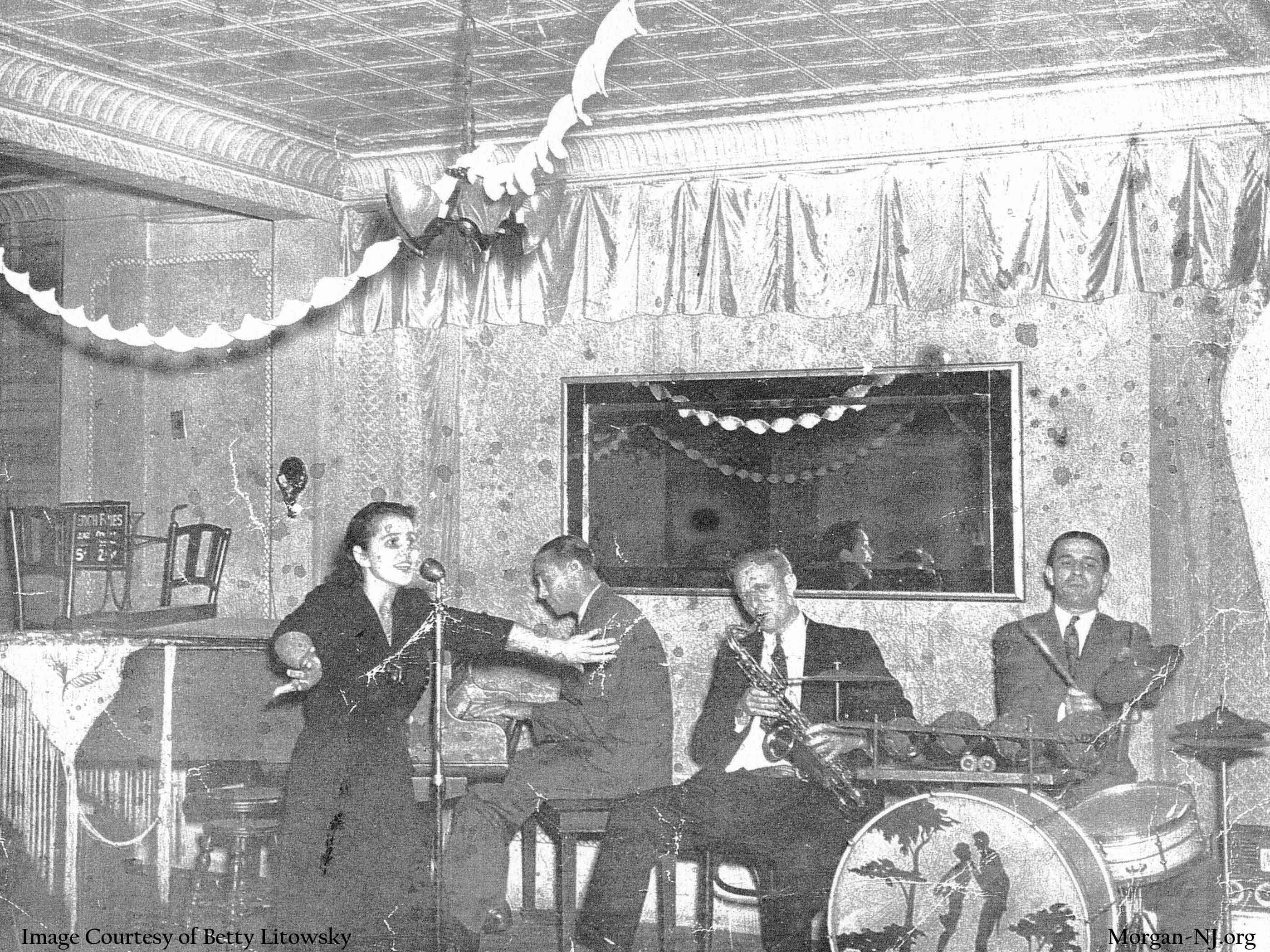
War-time entertainment by Ruth Macrae singing with Billy Coleman on piano, Mike O’ Brien on saxophone, and Eddie Coleman on drums, 1943. Image courtesy of Betty Macrae Litowsky.
For the years between the late 1800’s and the 1940’s, everything was delivered, bread, vegetables, milk, butter and cheese, ice, and of course, at the Robert E. Lee, beer and liquor. Those deliveries had to be checked and paid for. That job fell to my mother. She really was a jack of all trades. By day she was a caring mother and manager and bookkeeper. Come most evenings, she became a hostess and singer with the Colman Brothers Quartet, where she sang requests from the crowd and they always requested that she whistle Indian Love Call (whistling was very popular in those days, and guys like Bing Crosby, and other singers often augmented their crooning by whistling). Ruthie was a prolific whistler, she was always whistling while she worked. Nanna [i.e., Betty’s paternal grandmother, Elizabeth Geldhauser] thought it was “unseemly.” She said, “Whistling girls and crowing hens never come to very good ends” (she had a saying for almost any occasion). I will tell of some of them as the stories move along. I will try to have you understand what life was like during those lean, war years.
Each of the delivery men became like friends because they dropped in every couple of days. There was Ben the Baker, Ed the Ice Man (Nanna had an icebox at the Morgan Beach cottage, and of course the restaurant needed ice for the drinks behind the bar, and giant squares that were put into the “walk-in” on the thick layers of straw). The “walk-in” was a room that was built into the back wall of the chef’s kitchen; it had a big metal handle, and inside was thick wood, with giant hooks that protruded along the perimeter of the room used for hanging the meat. It was probably 10’ x 10’ and was surprisingly cold even on the hottest summer day.
During the war years, there were so many stories and anecdotes concerning life at the Robert E. Lee, it is difficult to know where to start. As little girls attending a Catholic kindergarten, we were probably a very incongruous pair standing on the bar holding hands singing, “You have come to my heart Baby Jesus”, while the hardened patrons sat quietly watching, many with tears running down their cheeks. On summer weekends and holidays there were “New York” reviews with professional entertainers, singers, dancers, and jazz trios. What more could an impressionable 5-year-old ask for? Sitting cross-legged on the floor of the improvised dressing room, I made up my mind show business was for me! I listened to the jukebox for hours by pressing a small red button in the back, allowing me to get one record after another without putting any nickels into the slot. I don’t think there was a single song that I hadn’t memorized and the records were replaced regularly!
There have been many storms that hit us over the years and since there was nothing between the bay and the back of the building, we had varying amounts of damage with each one. The worst beating that big old building ever took was after being hit by the hurricane of 1944. The waves were bashing against the back of the lower bar room, which had water up to its ceiling. The family huddled upstairs, daring to look out the window only when there was a moment or two of calm.
To me, it was very exciting! I guess when you are very young you never think anything really bad can happen to you. Of course, I was wrong because it was bad. The bulkheads were undermined and partially washed away, and the entire foundation was threatened as the cement of the basement walls began to crack. When it was all over, the devastation was extreme. All the furniture, the bar itself, and the beautiful jukebox, all ruined! As soon as the sun came out “never say die” Don Macrae, started cleaning up the debris, shoveling mud out the broken windows, all the while, dreaming of how great the “new” marine bar would be.
All the favors to all the handymen were called in. They were like bees buzzing all around the place. Saws burring, hammers banging, laughing and whistling, good-natured teasing, all this while making magic in the lower bar. The advertisement in the newspaper told all the waiting customers, anxious to come back to their favorite watering hole, “the new marine bar will be better than ever.” Everything was painted with shiny white enamel with royal blue touches of stenciled water birds and ship’s steering wheels. The steel posts, installed to brace the building were enclosed in wooden boxes then painted white. It was at this time that the entrance from the front parking lot was changed from steps to a very clever wooden gangplank which had thick ropes on either side instead of regular handrails. All the original small windows were exchanged for giant picture windows. Now customers had a panoramic view of the channel and the bay.
Of course, it was a hit!
The marine bar at the Robert E Lee was more popular than ever. The shuffleboard tournaments started up again. A week or two after that grand opening, it was just as if nothing ever happened. Everyone was happy, and of course, Don was off to a new project.
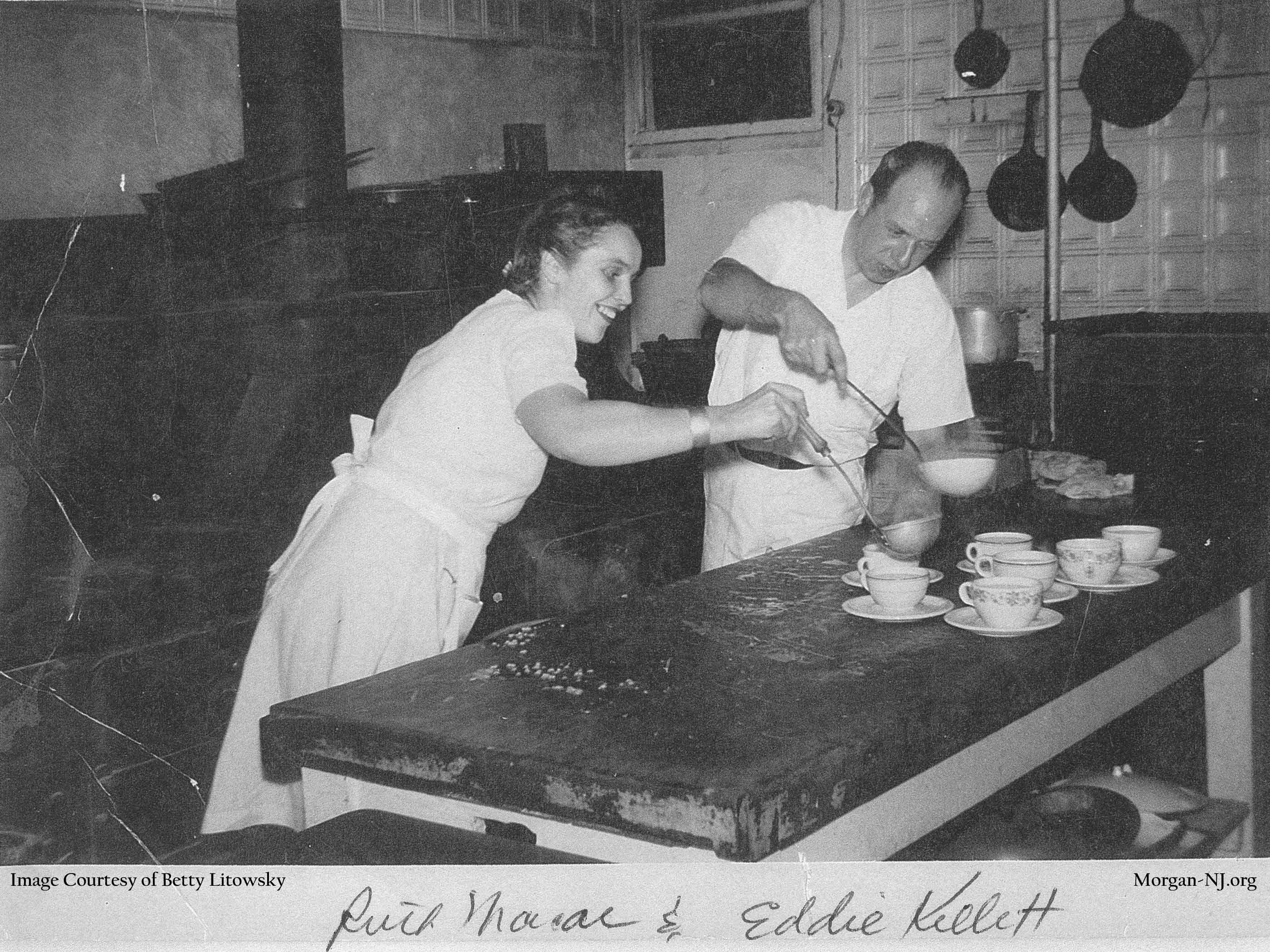
Ruth Macrae and Eddie Kellett in the Robert E. Lee Inn kitchen, 1942. Image courtesy of Betty Macrae Litowsky.
In the cold weather, especially if it had snowed, the bay and sometimes even the creek would freeze over! I remember one time some nut drove his big old black Ford way out past the rocks and the lollipop (that was a marker for the boats to be able to tell where the rocks started in the really high tide) somebody called the police and the Newark News photographer took pictures of that crazy guy way out there on the frozen bay. I really can’t remember if he had any trouble getting in but somehow he did, and everyone talked about it for years.

Cheesequake Channel between the Robert E Lee Inn and Morgan Beach, Circa 1950s. Image Courtesy of Bill Love.
The bay behind the Robert E Lee froze regularly, and I, adventuresome and foolhardy, decided to go ice skating on the back bay. I didn’t think it would make that much difference if I skated out where it was smoother, a little further out. I was wrong! Jeanne stood on the shore crying while I floundered in dangerously cold waters. I was out of breath from screaming for her to get help. She just kept crying, “You’re going to drown!” Someone inside heard the commotion and sent “Eddie the Crippled Cook” out to get me. I imagine it was quite a sight to see a limping man, all dressed in white, breaking through that thin ice to reach a freezing child bogged down with heavy wet clothes and men’s black skates that were filled with ice water. But he did and I lived to have many more adventures.
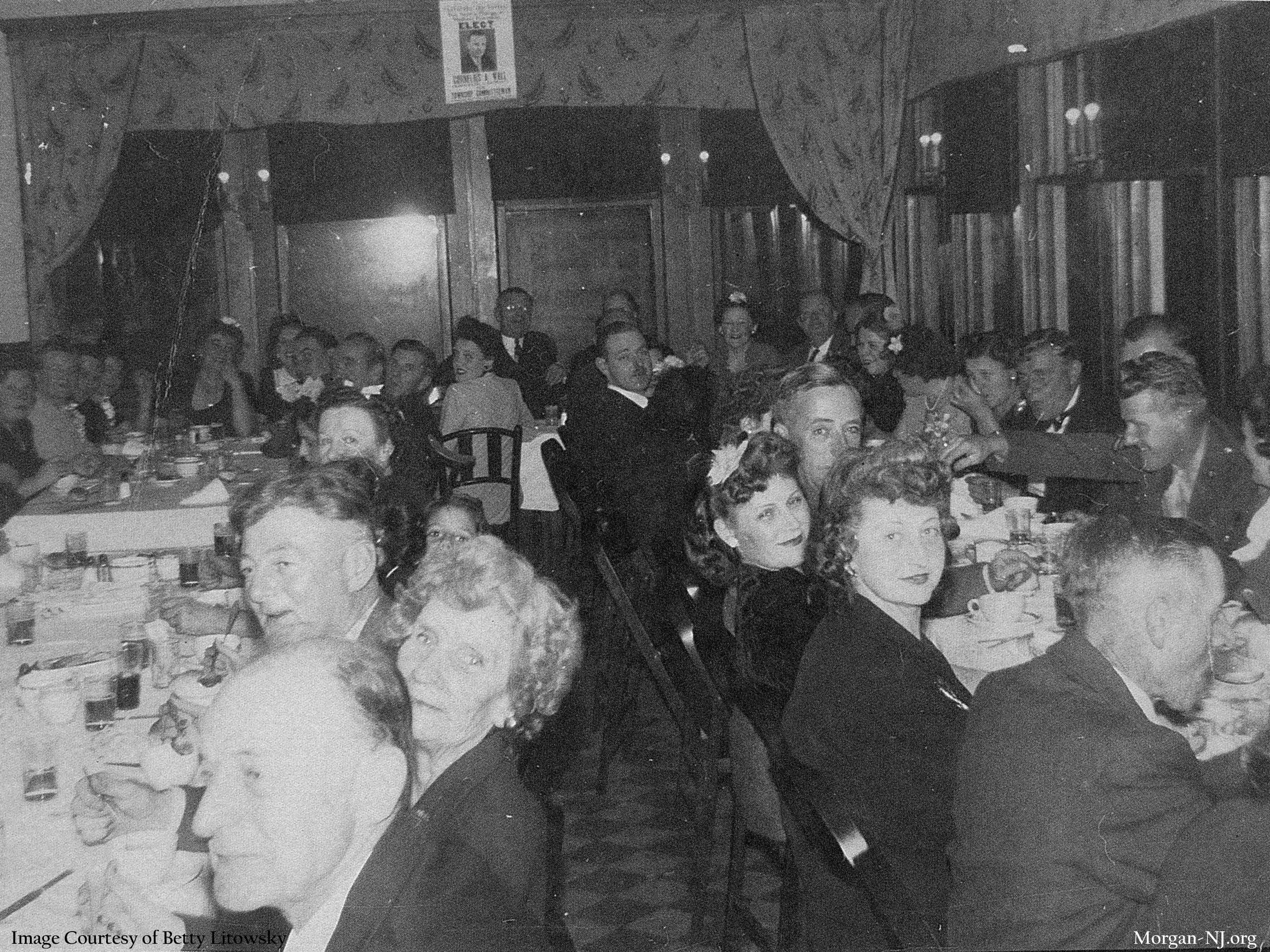
Political dinner for Commissioner C. Wall in the upstairs back dining room of the Robert E. Lee Inn, circa 1945. Image courtesy of Betty Macrae Litowsky.
When I think of Eddie Kellet, our cook, I think of the time during the height of the war when everything was rationed. Don, ever the entrepreneur, had an opportunity to host a very large political banquet. They wanted chicken as the main dish and were expecting 300 guests. Not wanting to make any excuses, Don agreed to a really good price per plate. He came home all excited, making plans about seating and decorations, when my mother, not wanting to rain on his parade but thinking “rationally,” simply asked, “Where are you going to get all those chickens?”
Silence. Then wild propositions, “the black market?”
Never! Steal them? Not honest Don! We can go down to Lakewood and make one of those old chicken farmers an offer he can’t refuse. That’s exactly what Don and “Eddie the Crippled Cook” did! They asked around to see if they could find some egg farmer that was ready to retire and buy all his chickens from him. They found a willing seller, made the cash exchange, shook hands and then, it hit him, “How do you get all these chickens into these crates?”
The old farmer answered, “Jes’ git into the pen and snare ’em with these snares.” OK – sounds easy enough. In the first 25 minutes or so they were doing alright but as the pen began to empty out a little, those chickens had a lot more “running room.” Eddie was tiring fast. “What do we do now?” Don asks the old man. “Jes’ keep chasin’ ‘em, they’ll git tired!” Don told that story with the accents and motions to go with them many times over the years – both as the storytelling master of ceremonies and in private settings over drinks.
The banquet went off without a hitch. He made what was a lot of money at the time, and a good time was had by all. The story about how the live chickens were “prepared” for the banquet is one which I may tell at another time (it is enough to say, I found many treasures in the gullets of those chickens, one of which was a gold ladies ring.)
Black Magic Cat
We had a cat named Magic who was pure black and hung out at that part of the kitchen like a guard against the rodents that roamed around the docks and bulkheads. He remained at the Robert E. Lee as if he were a permanent fixture when it was sold years later to a school friend of Don’s. The story of how Magic came to be the official kitchen guard is quite touching. One night, in the dead of winter, Don was returning home from Newark. The carriage house had not yet met the water spout and as he got out of his Chevy, he heard a screeching that he thought was human. He searched the dark corners and followed the sound. There, in the dark corner, was the tiniest little kitten he had ever seen. He picked it up and brought it in. The “experts” from the kitchen estimated it was 3or 4 weeks old, way too young to be away from its mother. Well, one of the waitresses named the kitten “Magic” for the song “It’s Magic,” which was popular at the time. He became the king of the kitchen and lorded over it over the black dog Teddy, who belonged to Ed and Delia, the couple who lived on the third floor in the suite. These two put on quite a show of “fake fighting” for anyone who was interested. They were the beloved couple that began working there right from the start and stayed until Ed got very sick, and while Delilah cared for him and continued to work, he got better but she died suddenly in 1947. Ed left and went to live with his daughter, who was a teacher in Washington, D.C. When he left, he bequeathed his faithful dog, Teddy, to the Robert E. Lee, where the black “Pomeranian/Spitz’ lived out his days on the porch, only stirring to chase the occasional water rat.
Something was always happening at our house.
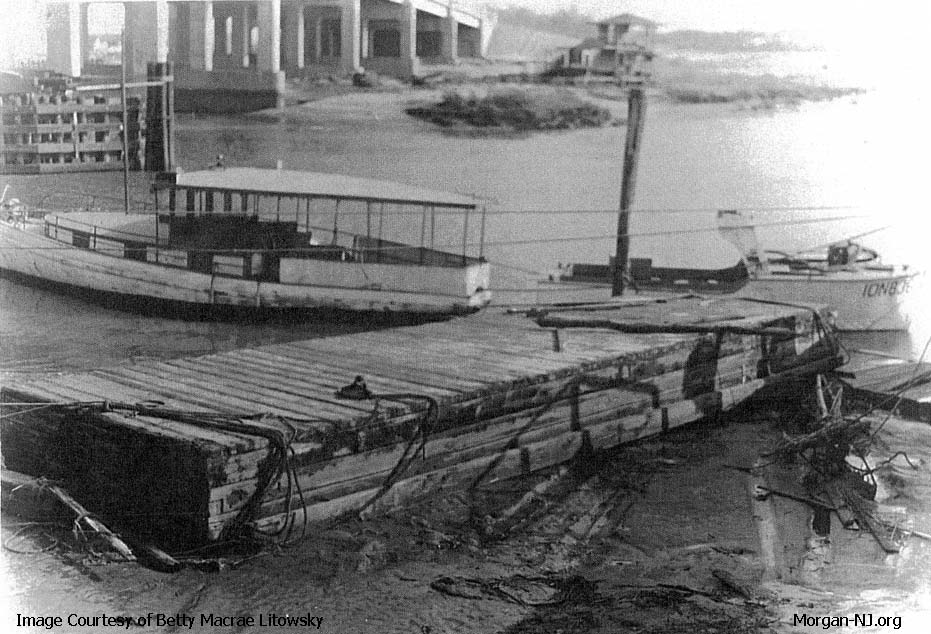
Looking Southeast Across Cheesequake from Luhrs toward the New 1943 New Jersey State Highway Route 35 Bridge. Image Courtesy of Betty Macrae Litowsky.
When they began to advertise that a new bridge would be built to replace the wooden drawbridge, Don, again with the mind of an entrepreneur, knew they would need to dredge the channel and they would have to have a barge from which the divers would descend to check the work the noisy pile drivers were doing. He had heard of a “floating dock” that a company was trying to get rid of. After taking some hidden money he had stashed to save up to buy my mother a fur coat (this, in the 1940’s, was a sign you had “made it”), he went to Staten Island where the barge was docked and made an offer. The owner accepted the offer and sealed the deal with a few drinks.
Now that he was the proud owner of a humongous barge, how was he going to get it back to the Robert E. Lee? After another couple of drinks, the guy offered to deliver it. “Great, I’ll drive back and be there when it arrives.” On the ride back, with reality setting in he knew he couldn’t possibly hide a barge the size of Rhode Island – and of course – would have to explain where he got the money. He began to sweat. What could he tell Ruthie when he got home? He pulled up, came inside to be greeted by a wife with her hands on her hips. “Where were you? “I was out buying you a fur coat”, and as if on cue, here comes the tugs, pushing the barge gingerly down toward the channel, “and if you look out the back window you can see it!” .She looked and saw the barge. “What’s that?” “I know it doesn’t look like it, but that’s your fur coat.” From that time on, until the bridge was completed, everyone referred to the barge as, “Ruthie’s fur coat.”
Since the entire coastline of the eastern seaboard opened up to the Atlantic Ocean, we were especially vulnerable to possible attacks from Western Europe. The summer of ’42 was a very exciting one for me. We had many unusual guests. One family, parents, three young children, and a grandmother lived in a huge tent. They had come from out west somewhere so the father could work in the shipyards. The country was building ships as fast as they could for the “war effort”. The family had an open vehicle that was a cross between a truck and a jeep. Attached to the back was a trailer for their speedboat, a long sleek thing with a big red stripe along the side of it. Don, ever the entrepreneur, made a deal to get a cut on every ticket sold at the dock entrance for an exciting boat ride. There was also a homemade “surfboard” that looked like a small platform with a slightly curved, sled-like front half that had two holes through which a rope was threaded and then attached to a single line that was attached to the back of the boat. It seemed to me everyone who tried to ride on it lasted no more than a couple of seconds in an upright position. Even Jack the boat owner had a hard time. The only person that I ever remember actually “riding” it was Don. I can still see him going so fast behind that speedboat down the channel and then out into the open bay; still standing, arms out holding the rope until he disappeared beyond the rocks and boulders that created the channel but blocked the vision of the southern part of the bay.
During the war years, the coast guard cutters used the deep water of the channel to give the sailors some protection and safety from the open waters of the bay. Believe it or not, there were sightings of German subs all up and down the New Jersey coast in the early 40’s. During the early fall of 1942, there were many news stories about an escapee from one of those purported German submarines. Everyone was on the lookout for this guy.
Late one night there was banging on the downstairs door. Don went down to see a large bearded seaman asking for a room to rent (the “third floor” was used as a rooming house for anyone passing through.) It was cold and damp and Don agreed, and led him up the stairs, where he immediately fell into a deep, snoring sleep. By now it was almost dawn, time for Don to leave for his job in Newark, where he worked as a glazier in the cold weather. He thought about the news stories and decided to call the state police to tell them of the midnight visitor. They told him they would be there within the hour.
After they arrived, Don pointed to the room at the top of the stairs, where the loud sound of snoring echoed down the hall. The Troopers came down almost immediately saying, “The only thing he could be arrested for was stinky feet!” This man said he was from Norway and that his name was Thor. He said he was an artist and would paint portraits or seascapes to pay for his room (I’m betting you can guess that this would have many stories attached to it.) He had to “be in the mood” to paint. One night, Don got up in the wee hours for a glass of water. The door to Thor’s room was wide open, and the room was empty. This gave young Don a bad feeling, and he began to search for him. Down in the coal cellar, drunk as a skunk was Thor. “What are you doing down here in the middle of the night?” After a pause, Thor said, “I was in the mood.” Don answered, “I hope you’re in the mood to go back to bed because that is where you are going, right now.”
Thor painted a beautiful rendering of the Robert E. Lee which hung over the bar for many years. Other people over the years claimed to be the artist, but after watching Thor, day after day, this giant bear of a man, with his little paintbrush stroke by stroke complete this large painting, I can tell you, Thor painted that picture!
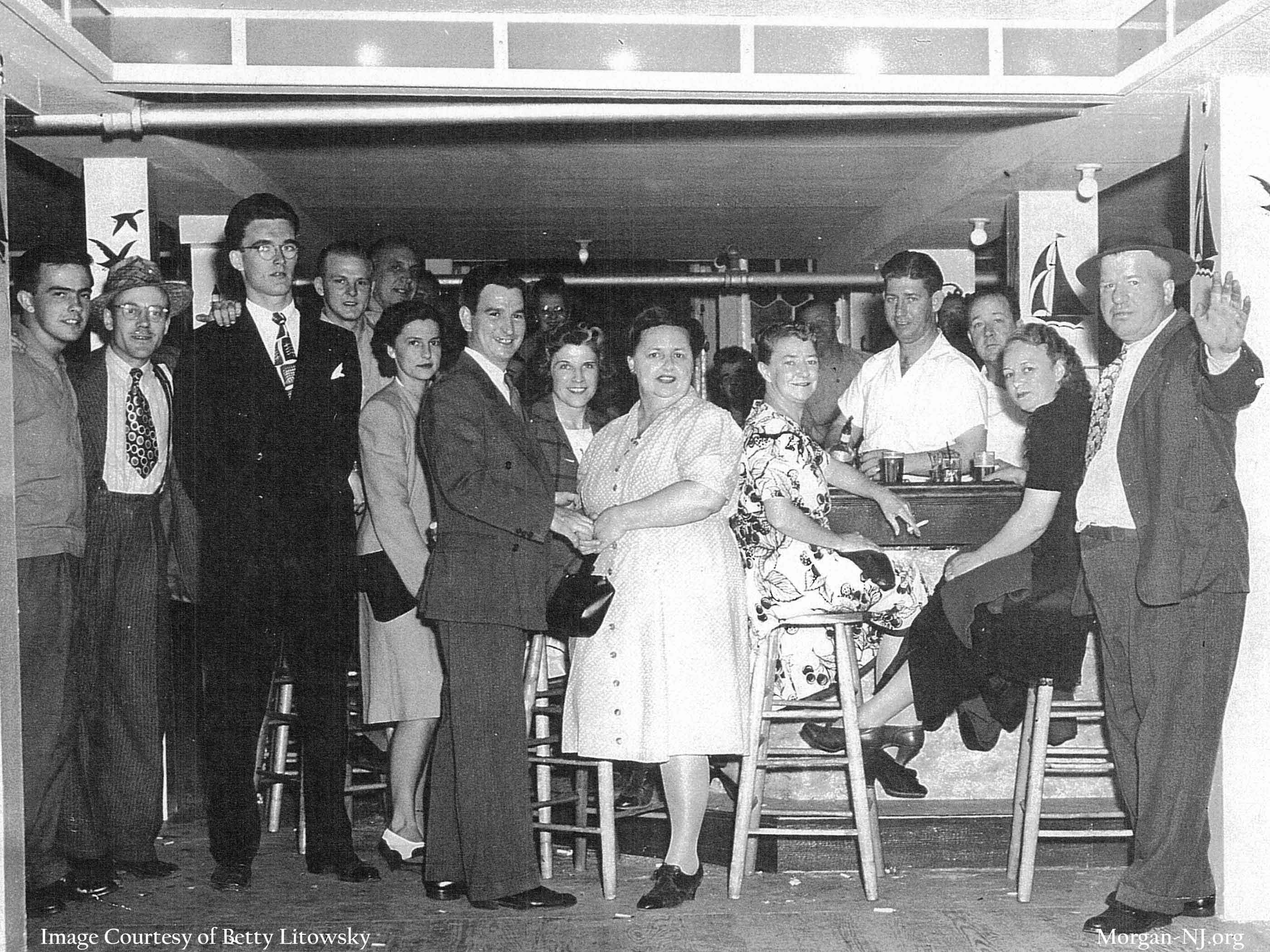
“The Gang” in the downstairs bar at the Robert E. Lee Inn, circa 1944. Image courtesy of Betty Macrae Litowsky.
The Christmas that I had just turned five (December 5, 1942), my father wanted to make the holiday extra special for Jeanne and me. He managed to get a Santa Clause suit big enough to fit on the biggest guy around, “Norman Marcella. Everyone called him “Fat Norman”‘ not to be confused with Norman Mascovitz, the piano teacher my mother swore that I drove to the brink of insanity (maybe over the brink, since he had some kind of break down and stopped giving piano lessons altogether). In any event, Fat Norman agreed to play the part of Santa and run across the parking lot while ringing a large bell (Once you’ve seen Norman, he would be very difficult to disguise – even in a red Santa costume wearing a beard). His walk was distinctive, too! All the grown-ups at the Inn were a part of the trickery. Everyone was saying, “He’ll be coming any time now. Keep looking out the window.” Jeanne and I were glued to the front window in the upstairs bedroom. Daddy yelled up the stairs, “I think I hear his bell!” We were transfixed. There, ‘running across the open parking lot was Norman ringing this old bell they used to let the people downstairs know the dumbwaiter was full. I recognized the sound of that particular bell right away and then I saw him. “How come Norman is wearing Santa Claus’s clothes?”
Talk about being a spoiler!
Of course, all the adults were hysterical. My sister was totally confused and by and large, the whole ruse was a bust!
I don’t remember much else about that year, except it snowed and I got a Shirley Temple doll, Jeanne got a doll too, a “magic skin” baby doll which she treated like a real baby. She loved babies and one night I saw her putting the doll inside the closet after we said our prayers. “Why are you putting the doll in the closet?” I asked, “Because I said a special prayer which I can’t tell anybody.” I asked a few times but she would not tell me what she prayed for so we both went off to sleep. In the morning, I was lying there wide awake, but just waiting to hear some kitchen noises before I got out of bed, and I saw Jeanne going over to the closet. She started to cry. “What’s wrong?” I asked. She looked really sad. “What?” “I asked God to make my doll into a real baby but she’s still a doll.” She was going to be four in June and this was probably February or March. She never lost that love for babies. For as long as she lived, babies were always nearby (either her own or someone else’s). She couldn’t pass by without reaching out to touch a baby.
Around that same time, I had a “Chucky”-like experience with my doll. Some customer came in with their little girl. She was about my age, and she was carrying a doll. Because we lived on that peninsula, there were no kids around most of the time so I was always anxious to have a playmate (besides my sister). I asked her if she would like to see my doll and I ran upstairs to get the Shirley Temple doll which was lying on the couch in the sitting room all dressed in that red and white polka dot dress. In those days, dolls were held together with big thick rubber bands, which allowed the arms and legs to be moveable, and sometimes the head too so she could turn. Also, many dolls had eyes that opened and closed, these too were held in place with elastic. I walked over to the couch, and when I picked up my doll, a shock went through my entire body! I had only the torso in my grip! The arms’ legs and head remained lying on the couch like some grotesque torture victim! I screamed. Not just a little yelp, but a blood-curdling sound that came from the soles of my feet, up into the back of my throat, and couldn’t stop! When I think of it now, I can still feel the fright! As you may guess every person in that building came bounding up those stairs: Ethel Kellet, in her waitress uniform, my mother, and Delilah with her eyes bulging out. They all tried to calm me, but I was in panic mode and it took some time to get me back to normal. I have no recollection of what became of the little girl with her “normal doll’ or who took away the “parts,” but the Doll Hospital in the shoemaker’s shop in South Amboy put Shirley back together again, but it was never the same. I don’t think I ever picked up any doll after that without gingerly poking it to see if it was going to fall to pieces like Shirley did that day in the sitting room.
They say that the way something makes you FEEL is what is remembered, not necessarily the specifics of a memorable incident. I believe that is true. I was petrified, and a weird, unworldly chill went right through my spine and I was frozen in place with a childish fright that I don’t ever want to have again.
The porch that wrapped around the entrance of the Inn was crowded by lilacs, on both sides, that were dark purple, light purple, and white. In the spring, you got the fragrance as far away as the highway. I always loved to wake up on the first warm morning; windows open wide and smell the lilacs. They were usually the first to bloom, then the forsythia and lastly the crocus and lily of the valley, all wildly fragrant. It was a big thrill to be the first one in your class to bring a bouquet for the Blessed Mother on the first day in May. We had a rather large statue in the far front corner of my third grade class, that is where we “crowned the virgin” every school day in May (the big crowning took place in the church, and some high school girl was chosen each year to wear a white gown and put the crown of flowers on the head of the statue of the Blessed Mother and then we all sang, “Mary, we crown thee with blossoms today”).
As I write this, I remember the thrill I felt when my sister Jeanne wore a borrowed wedding gown and walked to the front of the church with the beautifully woven circle of roses and lilies in her outstretched hands. It seems to me we don’t have any solemn times like that anymore. I remember thinking, many times, while we were singing in the choir, looking down at the bowed heads of all the people, “this is as close to heaven as you can get on this earth.”
I went to school at St. Mary’s in South Amboy, N.J. I really liked school. I had Sister Cosmos in kindergarten. I won’t name every teacher that I ever had (although I clearly remember each and every one of them). I went straight through the grammar school and would have finished up by graduating from the High School, but in the spring of my sophomore year, a fire destroyed the entire building and we were all forced to use the facilities at the public school. The days were split. We had to go to the afternoon session, while the other students that we displaced went in the mornings. To me that meant no extracurricular activities, coming home at 5:30 or later was not my idea of fun. That is how I came to graduate from Sayreville High but, again, that one’s a story for another day.
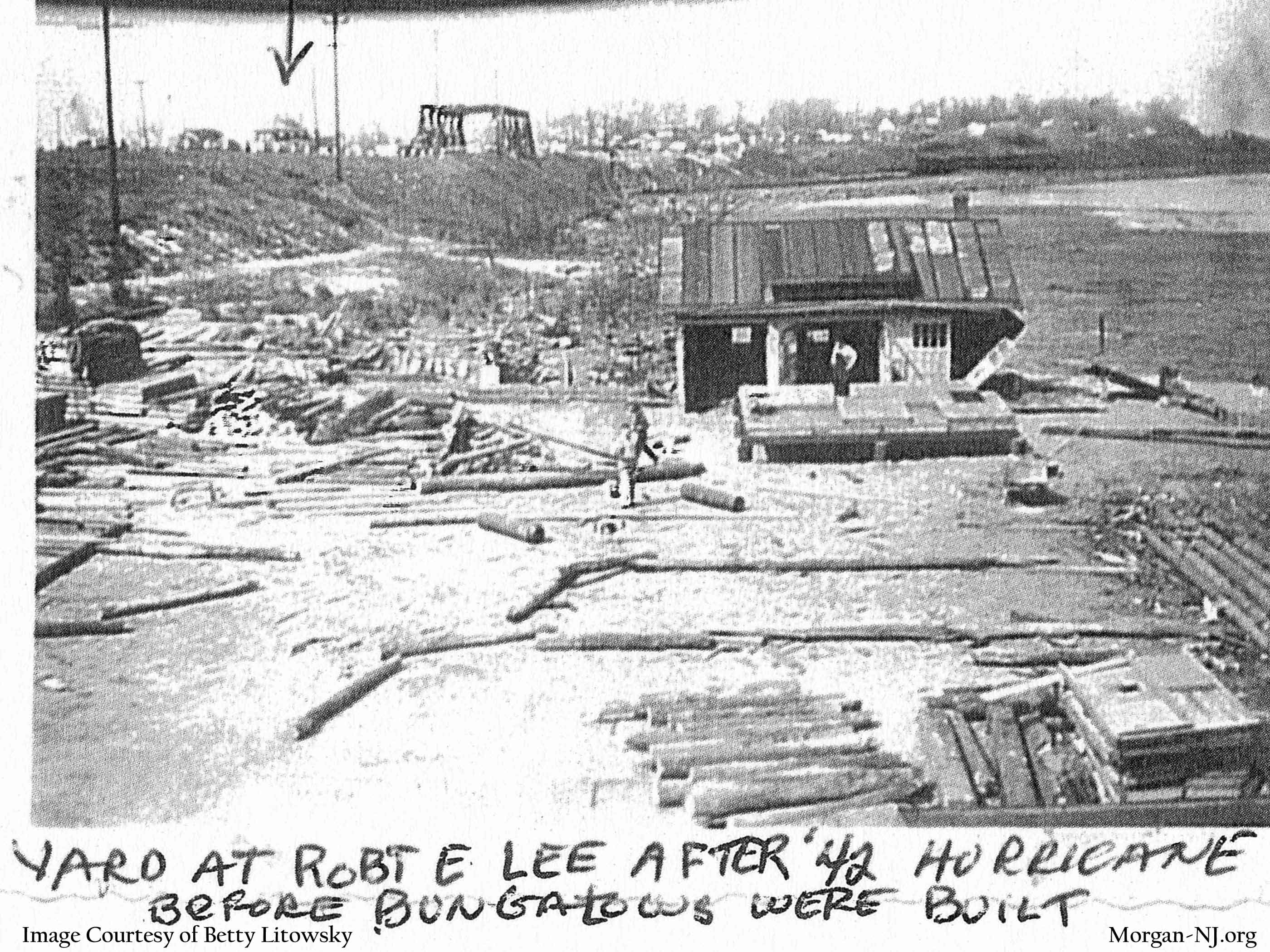
Looking Northwest from Robert E. Lee Inn toward the yard after the 1942 hurricane (this was before hurricanes were given yearly sequential alphabetical names). Notice the steam train in the background below “Morgan Heights”. Image courtesy of Betty Macrae Litowsky.
Spring at the Robert E. Lee was a time of planting and fixing anything that was broken during the winter. It was always a busy time for the handymen that were always in and out. There were bar stools to repair, tables legs to level out, trim to paint, awnings to put up. That was the time of the year that my father would be hoping to “beat last season’s figures,” which I think he did every year for all the years we lived there. There was a feeling of excitement and anticipation in the spring. I loved it!
Memorial Day was considered the official first day of the season (although if it happened to be an extra week in April or the beginning of May, we got a head start.) That was why at the first thaw those guys would be repairing the docks and washing the windows in the lower bar room. That’s where the shuffleboard and dart room was. That bar could be entered by a gangplank, instead of stairs, that had large rough ropes on each side instead of banisters to make it seem as if you were boarding a ship. It was a clever idea, and since the entire wall on the south and the one overlooking the bay were actually just big windows.
Everything down there was painted white with royal blue trim – quite nautical! There was a big Wurlitzer jukebox down there, it had all kinds of colors and bubbly tubes wrapping all over it (something a collector would give his eye teeth for today). There was also a cigarette machine that was very colorful when it was lit, but it was just mechanical. As far as getting the cigarettes out, you put the coins into the slot and then pulled out a long steel rod with a small handle on the end of it. Presto, out came the pack. My mother smoked a brand called Raleigh 903, it had coupons inside of the pack that could be collected and then cashed in for prizes (my grandmother said she was saving up for a coffin).
When I say everyone smoked in those days, I mean everyone. There were ashtrays in hospitals, airplanes, busses, even in doctor’s offices. Dr. Hoffman, from South Amboy, smoked while he was examining you! One day I got up the nerve to tell him that the cork end was showing. “Oh, I’m trying to cut down,” he said! I was designated to get cigarettes for anyone who wanted one (nobody else wanted to go down to the lower bar room where it was dark and cold, and had protective plywood covers on those big windows except in the summer). The machine took any denomination, but I would usually be given a quarter. After I put it in, there would be a dime in the change slot, and showing clearly through the cellophane would be three shiny pennies (those were mine). Even if your math is not great, you can figure cigarettes cost 12 cents a pack!
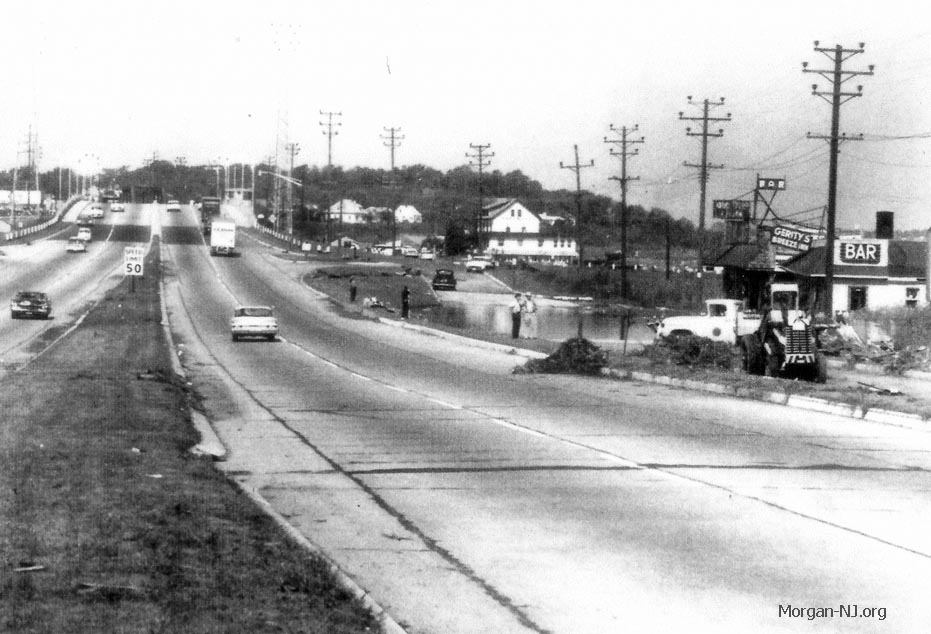
New Jersey State Highway Route 35 Looking Northwest toward Morgan Beach from Laurence Harbor, Circa 1960s. Gerity’s Breeze Inn and Bar is on the Right. Robert E Lee Inn is Left of Gerity’s. There Appears to be a Flood on the Old Road to the Left of Gerity’s.
Morgan, NJ was a really nice place to grow up. I knew it then, but only now do I realize how really lucky we were. The top end of the brick road was where we got off the school bus (when we were really little, my mother made arrangements for a high school girl to walk us down to the railroad tracks, where my mother would meet us). The bus stop was right in front of “Aunt Belle’s” house (one of the very few women who drove a car). There was Aunt Francis, Ethel Kellet (one of the waitresses at the Robert E. Lee) and Belle Gerity. That was it as far as female drivers were concerned. In 1940, women did not drive cars – at least not in Morgan. Belle Gerity was the recorder of vital statistics for Middlesex County and she knew everything about everybody. She knew every birth, every death, and every divorce that took place in the county. Her husband, “Uncle” Joe, was injured pretty badly while he was working for the electric company, and he didn’t drive, so that is why Aunt Belle drove everybody, everywhere.
Behind Aunt Belle’s house, there was a playground. It was the best place to play outside. There was a very high sliding board made of heavy shiny metal. Aunt Belle would give each of us a big-square of waxed paper which we could sit on as we slid down. As you can guess, after a few slides, we were flying! There were swings, a trapeze, rings, and a small merry go round. At the far end, there were baby swings (I don’t think I ever saw anybody use those swings, I guess Morgan didn’t have any babies at that time). There was a shoemaker that lived in the back of the playground. He had two boys, Nicky and Joey. It seemed to me they lived at the playground – they were always there.
Next door to the shoemaker was a taxidermist named Lee Clark. It was the most interesting place, and he was very willing to show all of his work to anyone who was interested. That was me! He had owls, beavers, raccoons, squirrels and any number of larger animals, like wolves – very interesting but very spooky (he kept it very dark in his workshop). My grandfather told me that he was very famous for work that he did that was on display at the Smithsonian.
Just behind both of those was Joe’s Kozy Bar. You could bring your own pot and they would fill it with spaghetti. I remember it as being delicious (this place later became “The Club Bene”, the owner was the same, Joe Benninato). In the 1960’s this place hosted the biggest stars, singers and comedians from “stage and screen.”
There are so many stories about Aunt Belle that it would probably be a complete book all on its own but I will try to relate some of them. As I have said before, Aunt Belle was one of the few women who could drive a car and she always had a car full of passengers, usually kids (mostly little girls, because she had two girls of her own, Janice, who was a cute, petite co-ed at St. Mary’s High and Patty, who was just a little older than me).
Across the street was Sherridan’s, a bar that was in the lower level of Tony Sherridan’s home. He lived there with his wife, and his daughter and granddaughter. The little girl was named Patti, too. Those two little girls were always together. Patty Gerity was small, with light curly hair. Patti (Tony’s granddaughter) was a little taller with long shiny black hair, and bright blue eyes. They were my idols, everything they wore was “gorgeous”, everything they said was interesting, and everything they did was something I was not allowed to do (unless Aunt Belle was with us, then I could). Aunt Belle took us to movies, to the circus, roller skating anything that would be interesting to kids. With Aunt Belle we could see the sideshow with its freaks and bearded ladies, my personal favorite, the snake woman (she sat in a large canvas tub, surrounded with snakes of all kinds, some of which bit her on various parts of her body, there were little bits of blood streaming from tiny bites everywhere). Like a car wreck, I couldn’t look away!
We went skating in Staten Island by ferry from Perth Amboy, with Aunt Belle’s car on board. This was a trip we made many times, and I always looked forward to the little man who walked around the ferry playing his concertina (an instrument that seems to have disappeared). It was a small octagonal accordion, a kind of “squeeze box,” a favorite used by the organ grinders with the little monkeys.
I realized that Aunt Belle was such a big part of anything we did between the ages of 6 and 10 that one “chapter” just wasn’t enough to tell of our exploits. After doing a minstrel show at St. Lawrence Church, certain acts were such “hits” that we took our act on the road, so to speak. Many hospitals, schools, and churches put on variety shows during those war years to make money for their particular projects. Our “act”, which consisted of five little girls dressed in blue and white gingham pinafore dresses singing “Take Me Back to New York Town”, with a finale that had us doing some simple dance steps that finished with a flourish of little dresses lifted up in the back to show rows of ruffled petticoats and lace bloomers. Aunt Belle sang “You Made Me What I am Today,” one of the hits of the “Gay 90’s” Review! The review picked up acts as it went along. Pretty soon we had a complete “Gay 90’s” show that, with Aunt Belle’s prompting, made the rounds of the veteran’s hospitals, schools, and churches around Middlesex County. I’m not sure if the other girls enjoyed it as much as I did, but the two Patties and I were the only ones that were ALWAYS there (my sister Jeanne, Barbara Troniec, and the Schonemonica girls alternated with us – it was fun)! Another unusual outing would be to attend funerals, especially if it was something interesting, like 3-month-old twins that died suddenly only two days apart or someone that had been in a car accident. I know it may sound macabre but we took it very seriously and sincerely prayed for their souls.
I loved Aunt Belle’s house, it had a hip roof and a big kitchen that you could enter from a small breezeway that was attached to the garage. She had a scrappy little Chihuahua named Susie. Susie would bark incessantly and nip at everyone’s ankles. Aunt Belle also had a plump black maid that seemed to always be there, although I know she lived somewhere else. She wore a kind of uniform and did a lot of ironing. She would put newspapers on the kitchen floor after she washed it (I always imagined the ink would dirty the floor again, but apparently it didn’t). Uncle Joe was always in the front room near the front door with his feet on an ottoman (because of his accident I guess). Then, last but not least, the Geritys had a summer house way down the shore, where for one week I was invited along with Patti Lauer (the other Patti) to the house in Bretton Woods. We did so many fun things that were typical of girls that age (I think I was 10). That was a very happy time.
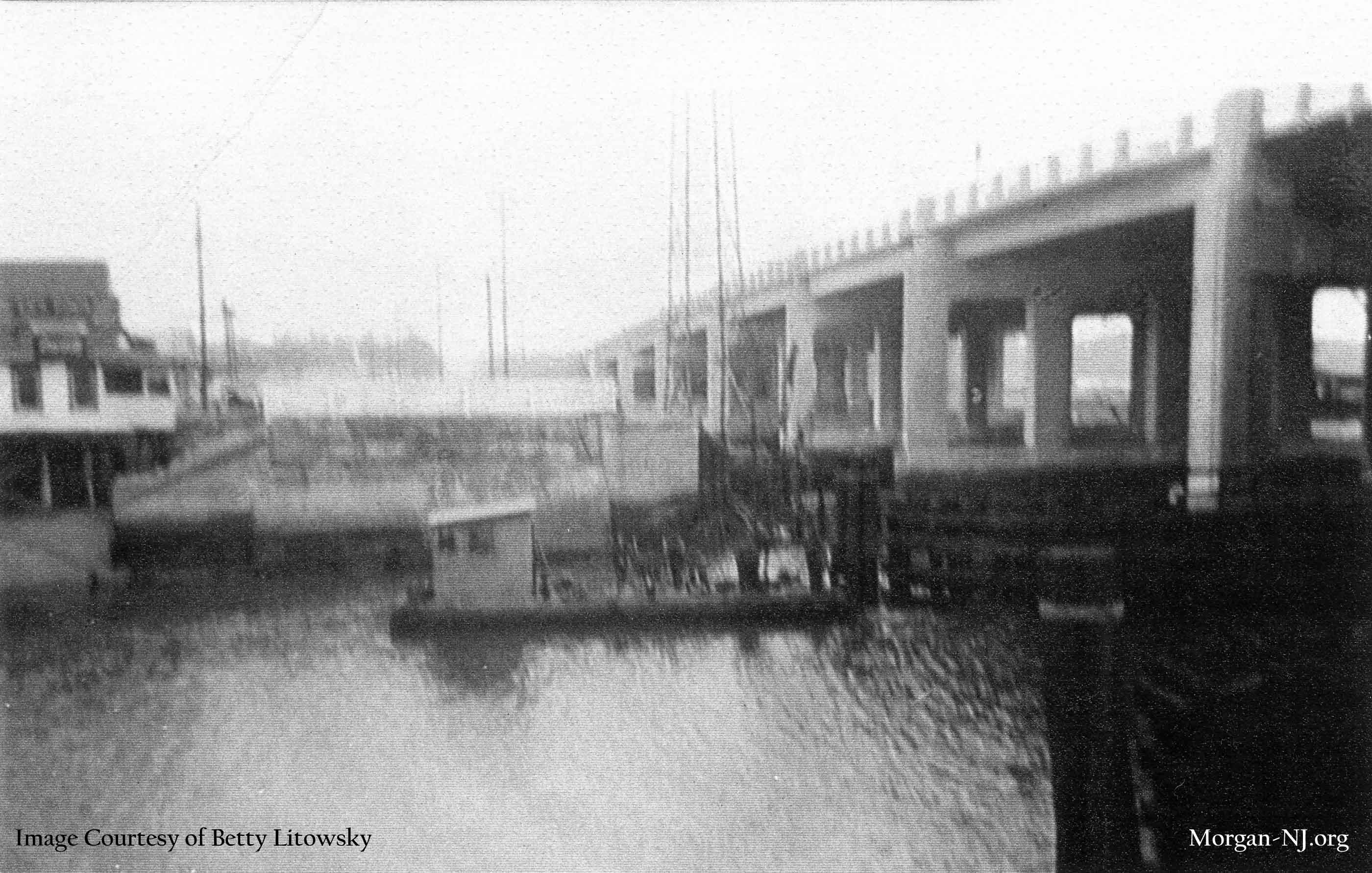
Looking Toward Morgan Beach from Robert E. Lee Inn in the 1940’s sometime after 1943. Kaiser’s Tavern on the left, old Route 35 in the center, new (and current) Route 35 Morgan Bridge on the right. Image courtesy of Betty Macrae Litowsky.
My sister Jeanne and I were much more sheltered than most of the other kids on the beach. We couldn’t run down to the “crik” to watch the big boats come in and watch the wooden drawbridge rise up at the sound of the clanging bell that sounded to notify everybody that the bridge was ready to go up. Sometimes it would just be a sailboat with a really high mast that could not be lowered enough to pass under the bridge (especially if the tide was in and the water rose all the way up to the bottom of the underpinnings of the bridge). In the warm weather, we played in the grounds surrounding the restaurant. I remember complaining to my mother once that there was nothing to do. She suggested that we lie down on our stomachs and quietly watch the ants building their homes. “They never rest,” my mother said, “you can come and watch them anytime, they are always working.” Can you imagine a child having so much time on his hands that watching ants build their hills seemed like fun?
In the nice weather, the music from the jukebox was pipped outside by speakers that were under the eaves of the third floor (it sounded so much better outside). We would sing our hearts out while we balanced each other up and down. We played Indians. Sometimes we would go into the wooded area behind the carriage house and pick the wild corn and search for berries along the east side where we would often see squirrels, chipmunks, and rabbits. I always tried to catch them but never did. I guess that life for two little catholic school girls who said a prayer to their guardian angels whenever they ventured any farther than the carriage house to play, was about as innocent as play can be!
Sometimes my own personal adventures were not quite as innocent. For example, one time we had “guests” on the third floor. It was a woman and two men. They were traveling photographers. They would advertise where they would be for a particular week, then take pictures of babies, families or portraits of individuals for professional reasons. They rented two rooms: one for the woman and the men stayed in one room. As I had mentioned before, in each closet there was a connecting “tunnel” between the rooms. I was so interested in just listening to them talk to each other, that I went to the end closet and crawled into the lady’s room where she was talking to one of her traveling companions. It was probably just small talk, but to me to hear them speaking to each other with their southern accents was better than going to the movies! That lady photographer taught me how to iron ruffles on a blouse, a talent which held me in good stead a few years later when I ironed many ruffles for my own little girl’s dresses (and every time, I always thought of that pretty lady with the accent).
We had all the “childhood” diseases. The only vaccination they had in the 40’s was for smallpox. Chickenpox was a doozy for me. My mother said that you could not place a dime anywhere on my body without it touching a “pox”. Even now, I would rather have pain than an unrelenting itch! There was nothing to do for it but allow it to run its course. My mother made a paste of water and baking soda, which she put into a small “monkey” dish from the chef’s kitchen. The idea was to pat it on the blisters to calm the itch. I was warned that if I scratched one, there would be a scar. For days I lived in the torture with that itch. I bit my lip and refused to scratch, all the while dipping the big cotton pad into the paste and patting as hard as I could so as to avoid ending up as just a walking pile of scars!
All of this was exacerbated by the fact that my sister threw all caution to the wind and scratched to her heart’s content. She, of course, only had a few isolated poxes, one here one there and could not have cared less if every one of them left a mark! But fate spared me when she got whooping cough and I didn’t. Her cough sounded like a barking dog, and for some unknown reason, she bent forward in a weird way just before each “bark. It was like a warning, “here it comes.” It was the most ungodly sound and especially since it was emanating from this pretty little blond child. As soon as I would see her starting to bend forward, I was out of there! Especially if there were people around!
I don’t know how long whooping cough lasts, but it seemed to me she was never going to get over it! A particularly embarrassing incident happened while we were shopping in Perth Amboy. It was probably around Easter, because we were not wearing coats, and we were looking at hats to wear to church. As we went from one hat store to the other, Jeanne would get that “look,” lean forward and go into that barking mode. It seemed that everyone within a mile would turn around to see where the noise was coming from. I started walking faster and tried to pretend I was not with the lady and the “barking” child. It didn’t do any good; they continued to catch up with me. The worst part, however, was when we got on the bus to go back home, she went into a barking frenzy! There was no escape. I slid down in my seat as far as I could and looked out the window. We finally got to our stop, and I was the first one off, again, walking ahead to get home as fast as I could trying to forget my embarrassment at being with a barking child.
Then came the worst of them all – measles! Here again, I had the intense version whereas Jeanne skated with a few red dots and a slight fever for a day or two. It all started in church where I was given the honor of singing a solo during the communion as the little ones received their first communion. My sister was in the class and Mr. Davies had it timed so that I could sing “You have come to my heart dearest Jesus” as my sister received her first holy communion (she was almost seven and I had just turned eight). That morning I didn’t feel right, but I said nothing because it was a big day and I didn’t want to spoil it. We got upstairs to the choir loft and I was feeling nauseous. Again, I did not want to say anything because mass was just starting and we were going to begin the singing.
Elaine Farley was standing next to me. Elaine was the oldest girl in the choir; she was out of high school and was sort of the proctor. I must have looked a little woozy because I remember she kept looking at me. The music swelled, we sang one hymn after another. The solo was next, “are you alright,” Elaine whispered? It was time for my solo. She tapped my shoulder and I began singing just as Jeanne was walking up to Father Kearney, his hand outstretched toward her. As I sang the last word of the song, the stained glass began to spin and I crumpled forward and probably would have fallen if it wasn’t for the railing. Mr. Davies went on playing, unaware that I was fading fast, but Elaine saw it and led me to the small landing going down the back staircase. It was there that I finally lost my breakfast (thank God I hadn’t eaten much). She was so kind (and so quick) I don’t think anyone noticed. She took me down to the ladies room, fixed me up, and just as quickly got paper towels and brought me back up to the loft. I don’t think anyone in the crowded church below had any idea what had just happened. As mass ended, my mother came to the entrance of the stairs to the choir with Jeanne in her little white dress and veil, as soon as she looked at me she knew “You look sick” she said as she touched my forehead. “You are burning up! We’ve got to get you right home.” As soon as we walked in the door she was on the phone asking if Dr. Hoffman could come down to the Inn to see me (can you imagine a doctor coming to your house fifteen minutes after you called him on a Sunday)? Anyway, I had a high fever and a rash on my stomach and back indicating to him I had a typical case of the measles. I had to be quarantined and kept in a dark room. There was a small daybed under the north window, and whenever I was sick or punished, that is where I slept. When Dr. Hoffman came up to the playroom where I was quarantined, after he entered he looked around at the various artworks hand drawn on the walls and asked, “where did you get this wallpaper?” I remember the shades had to be drawn so the sunlight couldn’t damage my eyes while I suffered with the measles (Jeanne never did get the measles so I guess the quarantine worked).
I had to be quarantined and kept in that dark room for what seemed like an eternity but was probably only a week or so. I could hear the people outside laughing and talking and I felt like the Prisoner of Zenda locked up in the spare room at the end of the hall, but I persevered and finally got better. It is amazing to think that measles, mumps, chicken pox, and whooping cough are all a thing of the past now that modern medicine has produced vaccines for all of those childhood sicknesses. For this, and so much else, we are so lucky. This is a good time to be alive on this earth and I truly believe it’s getting better all the time. Don’t go by what they say on the nightly news. Most of the bad stuff that you see on TV has been going on since the cave days, but they had no mass communication (plus, no one talked about such things). They were happening, but it was swept under the rug not put on Facebook and YouTube!
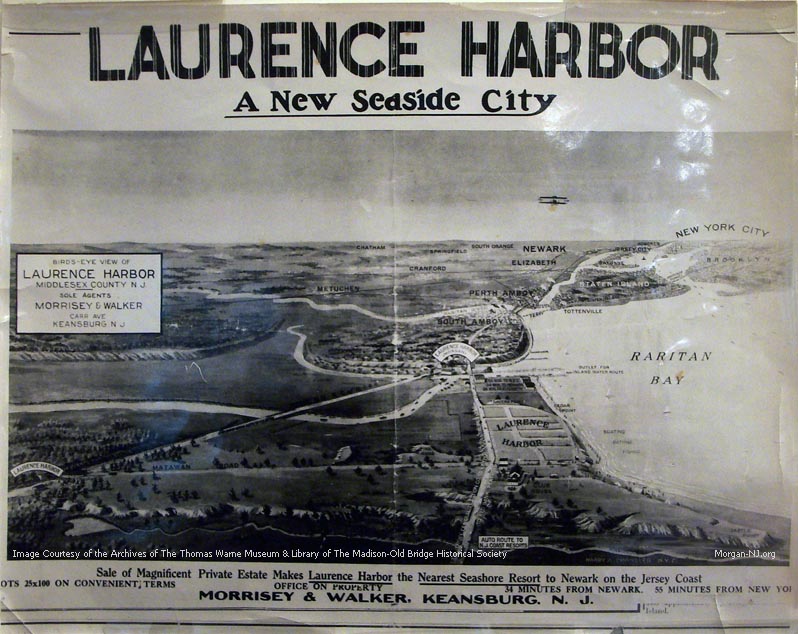
Early Twentieth Century Morrisey & Walker Newspaper Advertisement Selling Properties in Laurence Harbor, NJ. Morgan Beach is just above the “LAURENCE HARBOR” Highlighted Area. Image Courtesy of the Archives of The Thomas Warne Museum & Library of The Madison-Old Bridge Historical Society.
Anna Walker was Colonel Walker’s daughter. She was my “Nannan.” He was the Walker half of Morresey and Walker, the renowned builders of many of the small towns in Middlesex County (namely Laurence Harbor and Cliffwood Beach). Anna Walker’s “husband” Phil Doody, was Don’s partner for a very short time. The partnership broke up but not the friendship (I think Phil was killed in a motorcycle accident in the mid-40s). Right around that time, say 1944, they began to dredge the Morgan channel. They wanted it to be able to handle the Coast Guard cutters move easily. From ’42 until the end of the war, the Coast Guardsmen were regulars at the Robert E. Lee although members of any branch of the service were welcomed to spend time in our “USO Room” (which was a private room at the back of the banquet hall that was set up with comfortable chairs, jukebox, piano, large coffee urn and some other amenities for the exclusive use of servicemen and women although Nancy Tilquist was the only woman I ever saw in uniform). Since there were no nearby hotels or rooming houses, Don offered clean sheets and a hot bath for 50 cents up on the third floor.
Maybe the child of a man who was very well known in our “part of the world” would be the last to know, but it seemed to me that he was loved by everyone who knew him. It seemed the fun never really started until Don arrived! He put my mother, my sister, and me, on a sort of pedestal. I don’t know how it made them feel, but it made me feel as if I never wanted to disappoint him. I never wanted to disappoint my mother either, but I just seemed to know she was a completely soft place to fall. My sister and I were really lucky kids. I look back now and see clearly how difficult it must have been for them to keep the wheels turning. Everything we take for granted was much harder for, not only my parents but young people in general in those days.
Think of any daily chore that a housewife has today. Now, think of what that wife, living in a small town in New Jersey in the 1940’s had to cope with. Today, she would walk over to a thermostat, turn it to any temperature desired, and know that, immediately, the room would begin to rise to that temperature. Not so easy in the 1940’s. If our coal burning furnace started to cool off, someone (usually my mother) would have to quickly run down to the coal cellar and “stoke” the coal. If it had burned down all the way, the big shovel leaning on the wall would have to be used to shovel the ashes into an ash can and carried up the stairs afterward – but not before new coal was shoveled into the big, belching furnace!
Now take the chore of doing the family wash. Small things would be done by hand and hung on a clothesline at the far end of the property. Heavy things were done in the “wringer” wash machine, which had a round tub that looked like an oil can with an agitator down at the bottom. Next came the wicked wringer composed of two long narrow cylinders which were closely stacked on top of each other. The wringer had a crank handle that would be turned while the pieces of wet clothing were carefully threaded into the rollers. (Many a hand or fingers were crushed in those wringers). It was a really grueling job.
Then there was child care. If there was a baby or young child in the family, there were cloth diapers which were fastened with large “safety” pins. They had to be washed (and boiled) – it was a job! Cloth diapers also had to be emptied and rinsed out in the toilet before they could be put into the diaper pail. It is a wonder people EVER had a second child!
Then there was dinner. Usually on the table at 6 on the dot! Practically everything was made by hand. It was all very time-consuming. There was almost always a dessert, baked ahead of them in the late morning. The average person had no form of in-home air conditioning in 1940 (or the years following). My Aunt Helen was the only person I knew who had an air conditioner in her home in 1950 when I was about twelve. Imagine doing housework, making beds, ironing, and other jobs, on a hot summer day, with the windows open.
Why then, does everyone call those days, the “good old days”? I think it is because of the interaction between families and the closeness people felt for their friends and neighbors. I don’t think we have that kind of closeness today. I think we are missing out on a lot.
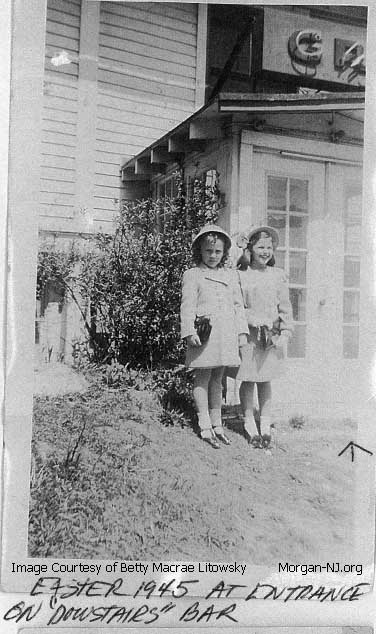
Sisters Jeanne and Betty Macrae Standing at the Entrance of the “Downstairs Bar” of the Robert E Lee Inn in Morgan, NJ Easter 1945. Image Courtesy of Betty Macrae Litowsky.
My sister Jeanne’s middle name was Emory. This was our maternal grandmother’s maiden name, and so, on her fifth birthday, Granny Keeler sent her a beautiful little gold ring with the initials of her maiden name in scroll, “I E” (her name was Isabelle Emory). Granny had worn it on her ring finger as a child, and then on her pinky for years. And so, when she gave it to Jeanne, it was a treasured gift. My mother called it the miracle ring after Jeanne lost it out of the third-floor window. Jeanne was waving to me down in the yard when it flew off her hand onto the slanted roof and into Never, Never Land. We didn’t know it then, but it landed in the upstairs rain gutter. Many days – or weeks – later, we were playing near the mailbox which was close to the drain pad of the downspout. There, lying in the sun, shining brightly, was her little gold ring! That was the first of many “miracles” that the little ring would be a part of.
Years later when we were in Keyport waiting for Nanna at Dr. Gesswein’s office, we were skipping on the sidewalk and Jeanne suddenly started to cry, “I lost my ring again!” We looked all around the sidewalk, but it snowed that week and it was all piled up on both sides of the sidewalk and the driveway. This time it looked hopeless! We searched all around where she had been skipping (even daddy came out to help). No luck. We had to go home, we were all feeling that this time it was gone for good. But never fear, it was the miracle ring, we would find it somehow. Months passed, spring was in the air and, again, we accompanied Nanna to the doctor in Keyport. We asked if we could look for the ring. My mother, ever patient, said yes, but “do not go beyond the driveway.” We played detective and made believe some rich person was paying us to find his priceless jewel. We looked in the grass alongside the walk (by now the snow was long gone and everything was in bloom). Jeanne gasped as she called to me, “I found it!” Sure enough, there was the shiny tittle circle of gold, right there in the crease by the walk! Unbelievable!
Daddy thought we were joking. Nope, no joke, she really had found it! My mother told her to be very careful because even a magic ring’s luck runs out eventually. Jeanne was in second grade, so I guess she was going to be seven at that time. She misplaced it a few times over the years, but, by and large, it was usually safely on her finger. As she got into the higher grades, I remember a few times when she had trouble getting it off, so she began to wear it on her pinky. I can see her hand as she worked on homework, or stirred her chocolate milk; that small gold band on her little finger.
Years later, after we moved to Laurence Harbor, we lived right near the big beach, the one that connects to Cliffwood. It was very crowded in the summer in those days because we had some rides and outdoor stands on the boardwalk (we even had a merry go round and a tilt a whirl). Anyway, we were at that beach all day, every day in the warm weather. We generally went home for a snack at lunch (we were so close)! This particular day I left a little early and was already sitting at the table when Jeanne came running in literally screaming! “I lost my ring!” Mommy, ever calm, said, “we’ll find it.” I’m thinking, “not this time, not in the sand!” But off they went. When they got to the beach, Mommy said, “where is your towel?” Right there, Jeanne points. They approached the beach towel, and my mother bends down, digs her hand into the sand, and as if by “magic,” picks up the ring! Come on! That’s crazy! But that is exactly what happened! I don’t remember any other “miracles” regarding Granny Keeler’s ring, but I do know Jeanne was wearing it the last time I saw her. She passed away on Father’s Day, in 1998. I miss her, and all the family members who are gone now, but the memories I have are so vivid, it seems like just yesterday we were skipping on that sidewalk in Keyport!
Looking back, I think my father really wished he had been a building contractor. He was always building something. When they were beginning to take down the small bridge, the proverbial light bulb went off over his head. He made arrangements to take the bridge tender’s little square house off their hands. That little house acted as our playhouse during the week and as Auntie Anna’s motel room on the weekend. It was a 12’ x 12’ room with a door on the front, a window on the right, a window on the left, with a blank back wall. It had a hip roof and the ceiling went up into a point. There was more than enough room for a pull out bed, a highboy dresser and a tiny round table with two small chairs. He built a foundation for it so that it was very sturdy.
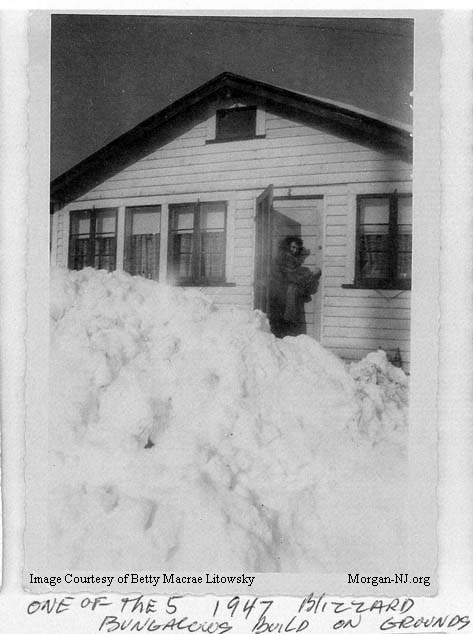
Robert E Lee Inn Guest Cottage after 1947 Blizzard in Morgan, NJ. These Cottages were Previously Camp Kilmer Barracks which were Sold as War Surplus. Image Courtesy of Betty Macrae Litowsky.
I think this is what gave him the idea for rental units there on the property. He couldn’t think of anything else. The war was coming.to a close. The boys were starting to come home. The army barracks at Camp Kilmer were up for destruction. Oh, wait! Those long narrow wooden buildings would make perfect little bungalows for the boys coming home with their “war brides.”
Well, they were shipped in on huge flatbed trucks, all in prefabricated sections. Those barracks became five individual houses. They were cut and separated, and four of them became comfortable homes; small but cozy. They each had deck-like porches, with a center entry door into a kitchen and dining area, which opened into a sitting room that had a bedroom attached. Directly between the kitchen wall and the bedroom wall was the bathroom. That was it. They were spoken for before they were finished! All four of them were rented continuously until the Inn burned down in 1981.
The fifth unit was enlarged and modified for Nanna and Grandpa. Theirs was similar but had a separate kitchen and living room. It also had an enclosed porch instead of a wooden deck. The bathroom was bigger too. By now, Nanna and Grandpa lived here all year around. There would be no more traveling back and forth to Irvington when the seasons changed. This arrangement was really a lot better for a lot of reasons – one was that Jeanne and I could see Nanna and Grandpa anytime we wanted!
Whether everyone involved was as happy as we were, I’m not sure but it was good. I remember how excited I was at the thought of having a playmate moving into one of the bungalows but in reality, there were quite a few children in those four homes. They were not all of appropriate ages, with most being too young, but there was Charlie Reisert, Cindy and Bobby Honeycutt, and the Bates children. It was a bumper crop of playmates! It was like going from zero to sixty in one day. We had a lot of fun, and we all took the same school bus, which by now, with so many more riders, stopped right in front of the Inn.
I look back at those years very fondly.
So many things rush into my mind when I think of those years, those years between the end of the great depression and the end of WWII. The music, the fear, the friendships – this was our country at its finest. I wonder if America will ever be that country again or is it just my reverie that makes it seem like we all lived in that shining city on the hill?
Originally posted on January 7, 2018. Updated on September 19, 2018.
